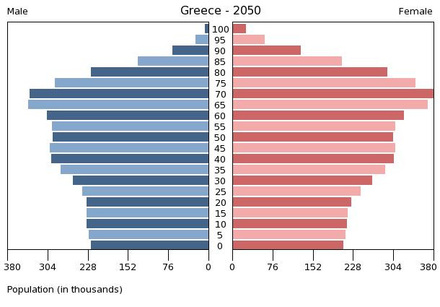Population Challenges

Greece has a very low natural growth rate. Women are having enough children to replace themselves and add a bit more to the existing population. Its population for now is 11.3 million, its projected population as 11.7 million by 2025. By 2050, the population is expected to fall to 11.5 million. (PRB)
Why is that? It’s because people are having less children. The life expectancy age is high too, at 80 years. When the midyear population aged 15-64 retire, the elderly support ratio will go from four working aged people per elderly person in 2010 to two working aged people per elderly person in 2050. The elderly people will begin to die off, and because of their significant numbers, it will result in a drop in the population. The natural growth rate is expected to be negative 0.2. (US Census Bureau) This represents the predicted Stage Five in the demographic transition. But before the elderly begins to die, the dependency load will be high. The children of today in the future will have to take care of the future large adult population above retirement age. This would mean longer working hours for the younger population.
Another problem is that you can see an imbalance of males and females in the older population on all population pyramids. The two populations are balanced in the younger populations, but the number of males significantly decrease as you go up the population pyramid. In general, females live longer than males by five years. This is because of old age and health issues relating to males.
Why is that? It’s because people are having less children. The life expectancy age is high too, at 80 years. When the midyear population aged 15-64 retire, the elderly support ratio will go from four working aged people per elderly person in 2010 to two working aged people per elderly person in 2050. The elderly people will begin to die off, and because of their significant numbers, it will result in a drop in the population. The natural growth rate is expected to be negative 0.2. (US Census Bureau) This represents the predicted Stage Five in the demographic transition. But before the elderly begins to die, the dependency load will be high. The children of today in the future will have to take care of the future large adult population above retirement age. This would mean longer working hours for the younger population.
Another problem is that you can see an imbalance of males and females in the older population on all population pyramids. The two populations are balanced in the younger populations, but the number of males significantly decrease as you go up the population pyramid. In general, females live longer than males by five years. This is because of old age and health issues relating to males.
